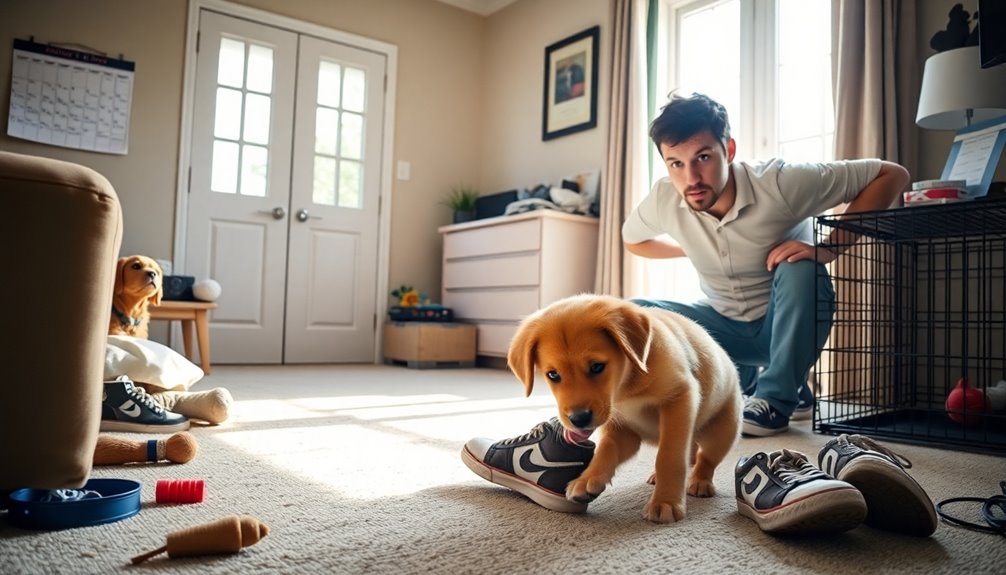By month, you can expect your puppy to hit key milestones like socializing with people and animals by 8-16 weeks, and beginning basic training such as sit, stay, and come. Crate training and housebreaking are also essential early steps. Each stage builds confidence and good behavior, so staying on track with socialization, training, and handling will help your pup grow into a well-rounded dog. Keep exploring to see how each milestone fits into your puppy’s development.
Key Takeaways
- Monitor socialization progress by exposing your puppy to new people, animals, and environments within the recommended age window.
- Ensure basic obedience commands like sit, stay, and come are introduced and reinforced consistently from 8 to 16 weeks.
- Use positive reinforcement and short training sessions to build confidence and establish good habits.
- Gradually introduce crate training and housebreaking routines to promote safety and independence.
- Watch for signs of stress or overwhelm, and provide calming activities to support your puppy’s emotional development.

Bringing home a puppy is an exciting adventure, and understanding their developmental milestones can help you provide the best care at each stage. During the first few months, your puppy is rapidly growing and learning about the world around them. One of the most important aspects of this period is socialization. Early socialization strategies involve exposing your puppy to different people, other animals, sounds, and environments in a positive and controlled way. This helps prevent future behavioral issues and builds their confidence. You should start socializing your puppy as soon as possible, ideally between 8 and 16 weeks old, but always guarantee experiences are gentle and safe. Use treats, praise, and patience to encourage positive associations, and keep interactions calm to avoid overwhelming your puppy.
Start socializing your puppy early between 8-16 weeks with gentle, positive experiences to build confidence and prevent behavioral issues.
Training tips during this stage are equally critical. Focus on basic obedience commands like sit, stay, and come, using positive reinforcement methods. Keep training sessions short—around five to ten minutes—so your puppy remains engaged without becoming fatigued. Consistency is key; use the same commands and cues, and establish a routine so your puppy knows what to expect. Crate training is also essential, as it provides a safe space for your puppy and helps with housebreaking. Remember to introduce the crate gradually, making it a positive environment with treats and toys.
At this age, puppies are also developing their bite inhibition, which involves teaching them not to bite or nip too hard. Redirecting biting behavior to toys and providing appropriate outlets helps them learn acceptable ways to interact. Socialization strategies should include gentle exposure to different surfaces, sounds, and handling by different people to foster a well-rounded, confident dog. Be mindful of not overwhelming your puppy; if they seem stressed or scared, give them space and return to more familiar, calming activities. Additionally, providing appropriate chew toys can aid in teething and reduce undesirable biting.
Your approach to training tips and socialization strategies during these early months lays the foundation for a well-behaved adult dog. Be patient and consistent, and celebrate small successes. Remember, this period is about building trust and confidence, so keep interactions positive and fun. By providing a supportive environment, you’re helping your puppy develop into a happy, well-adjusted companion who’s ready to explore the world with curiosity and confidence. This combination of early socialization and effective training sets the tone for a lifetime of good behavior and strong bonds between you and your furry friend.
Frequently Asked Questions
When Should I Start Training My Puppy?
You should start training your puppy as soon as you bring them home, usually around 8 weeks old. Early training includes establishing routines, crate training, and basic commands. Make sure your puppy’s nutrition supports their development, as a healthy diet aids learning. Consistent, positive reinforcement helps your puppy learn quickly, so start gentle training from day one. This sets the foundation for good behavior and a happy, well-adjusted dog.
How Do I Socialize My Puppy Effectively?
To socialize your puppy effectively, start early by arranging puppy playdates with well-behaved pups, ensuring positive experiences. Enroll in socialization classes to expose your puppy to different environments, sounds, and people. Always supervise interactions, reward good behavior, and keep sessions short and fun. Consistent socialization helps your puppy build confidence and good manners, setting a strong foundation for a well-adjusted adult dog.
What Should I Do if My Puppy Is Not Gaining Weight?
Imagine your puppy’s growth as a delicate garden needing extra care. If your puppy isn’t gaining weight, you should immediately consult a veterinarian to identify any underlying issues. They might recommend nutritional supplements tailored to your puppy’s needs. Don’t wait—early intervention can turn things around, ensuring your pup grows healthy and strong. Regular veterinary check-ups are key, and supplements can help fill nutritional gaps along the way.
How Can I Tell if My Puppy Is Teething?
You can tell your puppy is teething if you notice drooling, chewing on furniture, or biting everything in sight. Keep an eye on their puppy dental health by checking for swollen gums or loose teeth. To ease discomfort, try safe teething remedies like cold toys or chilled treats. Providing appropriate chew toys helps soothe their gums and supports healthy teething habits, making the process more comfortable for your little one.
When Is the Best Time to Spay or Neuter?
You should consider spay timing and neuter benefits to determine the best time for your puppy. Most vets recommend spaying or neutering between 4 and 6 months old, but this can vary based on breed and health. Early spay or neuter benefits include reducing unwanted behaviors and health risks. Talk to your vet to decide the ideal timing for your puppy, ensuring a healthy and happy life ahead.
Conclusion
As you navigate your puppy’s first year, remember that each milestone is a stepping stone in their growth journey. Think of these months as the chapters of a story, with your puppy as the enthusiastic protagonist learning and thriving. Stay patient and consistent, and you’ll see their personality blossom like a flower in spring. Trust the process and enjoy every moment—soon enough, your little pup will be a loyal companion, blooming beautifully through each milestone.










